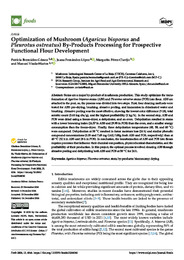Por favor, use este identificador para citar o enlazar este ítem:
https://hdl.handle.net/11000/35018Registro completo de metadatos
| Campo DC | Valor | Lengua/Idioma |
|---|---|---|
| dc.contributor.author | Bermúdez Gómez, Patricia | - |
| dc.contributor.author | Fernandez-Lopez, Juana | - |
| dc.contributor.author | PÉREZ CLAVIJO, MARGARITA | - |
| dc.contributor.author | Viuda-Martos, Manuel | - |
| dc.contributor.other | Departamentos de la UMH::Tecnología Agroalimentaria | es_ES |
| dc.date.accessioned | 2025-01-20T10:41:19Z | - |
| dc.date.available | 2025-01-20T10:41:19Z | - |
| dc.date.created | 2024-12-14 | - |
| dc.identifier.citation | Foods 2024, 13(24), 4046 | es_ES |
| dc.identifier.issn | 2304-8158 | - |
| dc.identifier.uri | https://hdl.handle.net/11000/35018 | - |
| dc.description.abstract | Stems are a major by-product of mushroom production. This study optimizes the transformation of Agaricus bisporus stems (ABS) and Pleurotus ostreatus stems (POS) into flour. ABS are attached to the peat, so, the process was divided into two steps. First, four cleaning methods were tested for ABS: pre-drying, brushing, abrasive peeling, and immersion in chlorinated water and brushing. Abrasive peeling was the most effective, showing the lowest color difference (9.18), total aerobic count (3.48 log cfu/g), and the highest profitability (1 kg/h). In the second step, ABS and POS were dried using a freeze-dryer, a dehydrator, and an oven. Dehydration resulted in stems with a lower browning index (24.57 in ABS and 29.95 in POS) than the oven, and a smaller energy consumption than the freeze-dryer. Finally, three dehydration temperatures (40, 50, and 60 °C) were compared. Dehydration at 50 °C resulted in faster moisture loss (24 h) and similar phenolic compound concentrations (3.35 and 7.69 mg GAE/100g fresh ABS and POS, respectively) than at 40 °C (32 h in ABS and 28 h in POS). In conclusion, the transformation of ABS and POS into flours requires processes that influence their chemical composition, physicochemical characteristics, and the profitability of their production. In this project, the optimal process involved cleaning ABS through abrasive peeling and dehydrating both ABS and POS at 50 °C for 24 h | es_ES |
| dc.format | application/pdf | es_ES |
| dc.format.extent | 16 | es_ES |
| dc.language.iso | eng | es_ES |
| dc.publisher | MDPI | es_ES |
| dc.rights | info:eu-repo/semantics/openAccess | es_ES |
| dc.rights | Attribution-NonCommercial-NoDerivatives 4.0 Internacional | * |
| dc.rights.uri | http://creativecommons.org/licenses/by-nc-nd/4.0/ | * |
| dc.subject | Agaricus bisporus | es_ES |
| dc.subject | Pleurotus ostreatus | es_ES |
| dc.subject | Stem | es_ES |
| dc.subject | By-products | es_ES |
| dc.subject | Bioeconomy | es_ES |
| dc.subject | Drying | es_ES |
| dc.title | Optimization of Mushroom (Agaricus bisporus and Pleurotus ostreatus) By-Products Processing for Prospective Functional Flour Development | es_ES |
| dc.type | info:eu-repo/semantics/article | es_ES |
| dc.relation.publisherversion | https://doi.org/10.3390/foods13244046 | es_ES |

Ver/Abrir:
Optimization of Mushroom (Agaricus bisporus and.pdf
1,74 MB
Adobe PDF
Compartir:
 La licencia se describe como: Atribución-NonComercial-NoDerivada 4.0 Internacional.
La licencia se describe como: Atribución-NonComercial-NoDerivada 4.0 Internacional.
.png)